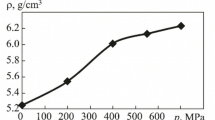Conclusions
The compound TiFe can be synthesized by annealing compacts from mixtures of titanium and iron powders in a hydrogen atmosphere. The homogeneity of the sintering products of titanium and iron can be approximately assessed by determining the amount of hydrogen absorbed by them during sintering. The sintering of compacts in unpurified hydrogen is accompanied by the formation of complex oxygen-containing phases based on the intermetallic compounds of the Ti-Fe system.
Similar content being viewed by others
Literature cited
L. I. Kivalo, V. V. Skorokhod, and N. F. Grigorenko, “Volume changes accompanying the sintering of compacts from mixture of titanium and iron powders,” Poroshk. Metall., No. 5, 17–21 (1982).
L. I. Kivalo, V. V. Skorokhod, and V. Ya. Petrishchev, “Dilatometric investigation of the sintering of compacts from titanium and iron powder mixtures,” Poroshk. Metall., No. 7, 26–29 (1982).
M. Hansen and K. P. Anderko, Constitution of Binary Alloys, McGraw-Hill, New York (1957).
J. J. Reilly and R. H. Wiswall, “Formation and properties of iron-titanium hydride,” Inorg. Chem.,13, No. 1, 218–222 (1974).
L. I. Kivalo, V. V. Skorokhod, and V. Ya. Petrishchev, “Effect of nickel on sintering processes in the Ti-Fe system,” Poroshk. Metall., No. 8, 24–27 (1983).
W. Müller, D. Blackledge, and D. Liebowitz (eds.), Metallic Hydrides [Russian translation]., Atomizdat, Moscow (1973).
E. Ence and H. Morgolin, “Re-examination of Ti-Fe and Ti-Fe-O phase relations,” J. Met.,8, No. 5, 572–577 (1956).
L. I. Mirkin, Handbook of X-Ray Structural Analysis of Polycrystals [in Russian], Fizmatgiz, Moscow (1961).
V. V. Skorokhod and S. M. Solonin, Physicometallurgical Principles of Sintering of Powders [in Russian], Metallurgiya, Moscow (1984).
G. V. Samsonov (ed.), Properties of the Elements (Handbook) [in Russian], Vol. 1, Metallurgiya, Moscow (1976).
M. H. Mintz, Z. Hadary, and M. P. Dariel, “Hydrogenation of oxygen-stabilized Ti2Mx (M = Fe, Co, Ni, O ⩽ x ⩽ 0.5) compounds,” J. Less-Common Met.,74, No. 3, 287–294 (1980).
W. Rostoker, “Selected isothermal sections in the Ti-rich corners of the systems TiFe-O, Ti-Cr-O, and Ti-Ni-O,” Trans. AIME, 203, No. 3, 113–118 (1955).
Author information
Authors and Affiliations
Additional information
Translated from Poroshkovaya Metallurgiya, No. 4(280), pp. 34–40, April, 1986.
Rights and permissions
About this article
Cite this article
Antonova, M.M., Privalov, Y.G. Sintering behavior of compacts from a mixture of titanium and iron powders in hydrogen. Powder Metall Met Ceram 25, 291–296 (1986). https://doi.org/10.1007/BF00794407
Received:
Issue Date:
DOI: https://doi.org/10.1007/BF00794407



